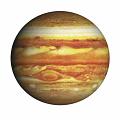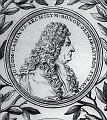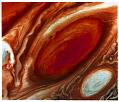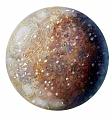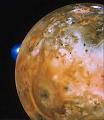THIS HUGE, BRIGHT PLANET is the largest world in our solar system; four of its moons are the size of planets. It is different in structure from the solid inner planets. Apart from a small rocky core, Jupiter is mainly hydrogen and helium. Below the cloudy atmosphere, the pressure is so great that these are liquid rather than gas. Deep down, the liquid hydrogen behaves like a metal. As a result, Jupiter has a strong magnetic field and fierce radiation belts. Jupiter emits more heat radiation than it receives from the Sun, because it continues shrinking at a rate of a fraction of an inch per year. Had Jupiter been only 13 times more massive, this contraction would have made the center hot enough for nuclear fusion reactions (p.38) to begin, though not to be sustained for as long as in a star. It would have become a brown dwarf- a body between a planet and a star: The Gallleo spacecraft, which orbited Jupiter from 1995-2003, transmitted some amazing photographs of Jupiter and its moons. Read some facts about Jupiter at the bottom, or click here.
Jupiter's Rings
The US Pioneer missions were sent past Jupiter in the early 1970s, Pioneer 10 sending back the first pictures. In 1977 the US sent two Voyager probes to explore Jupiter's cloud tops and five of its moons. Voyager 1 uncovered a faint ring-like Saturn's rings (p.53)-circling the planet. The thin yellow ring (approximately 18 miles thick/30 km) can be seen at the top of the photograph.
Seeing the Red Spot
In 1660 the English scientist, Robert Hooke (1635-1702), reported seeing "a spot in the largest of the three belts of Jupiter." Gian Cassini (p.28) saw the spot at the same time, but subsequent astronomers were unable to find it. The Great Red Spot was observed again in 1878 by the American astronomer Edward Barnard (1857-1923).
Jupiter's Clouds
The cloud tops of Jupiter seem to be divided into a series of bands that are different colors. The light bands are called zones, and the dark bands belts. The north tropical zone (equivalent to our northern temperate zone) is the brightest, its whiteness indicating high-level ammonia clouds. The equatorial belt, surrounding Jupiter's equator, always seems in turmoil, with the atmosphere constantly whipped up by violent winds. Across the planet are a number of white or red ovals. These are huge cloud systems. The brown and orange bands indicate the presence of organic molecules including ethane.
A Momentous Impact
In july 1994, fragments of the comet Shoemaker- Levy 9 crashed into jupiter's southern hemisphere at speeds of around 130,500mph (210,000km/h). The comet had been discovered in 1993by astronomers Carolyn and Eugene Shoemaker and David Levy,who also predicted its path. It was the first time in history that astronomers had been able to predict a collision between two bodies in the solar system and then observe the event. Over 20 pieces of the comet hit jupiter, some of them sending up 1,865-mile- (3,000-km-) high fireballs and plumes.
Spinning Jupiter
It is logieal to make assumptions from what your senses during its orbit tell you. From Earth it looks as if the heavens are circling over our heads. There is no reason to assume that Earth is moving at all. Aneient philosophers, naturally, believed that their Earth was stable and the eenter of the great eosmos. The planets were arranged in a series of layers, with the starry heavens-or the fixed stars, as they were called forming a large crystalline casing.
Jupiters Moons
In 1610, Galileo (p.20) made the first systematic study of the four largest moons of Jupiter. Since they seemed to change their positions relative to the planet every night, he concluded, correctly, that these objects must be revolving around Jupiter. This insight provided more ammunition for the dismantling of the geocentric theory (p.ll), which placed Earth at the center of the universe. In 1892 another small moon was discovered circling close to the cloud tops of the planet. To date, a total of 63 moons have been discovered.
Callisto
Callisto is the second-largest of Jupiters moons, and the most heavily cratered, not unlike our Moon, except that the craters are made of ice. The brigh t areas are the ice craters formed by impacts of objects from space.
Eruption on Io
Io is the Moon that is closest to Jupiter. It is one of the "Galilean" moons, named after Galileo, who discovered them. The others are Callisto, Europa, and Ganymede. The erupting plume of a massive volcano can be seen here on the horizon, throwing sulfuric materials 185 miles (300 km) out into space. The photograph was taken by Voyager from a distance of 310,700 miles (500,000 km) and has been specially colored using filters.
Facts about Jupiter
- Sidereal period 11.86 Earth years
- Temperature at cloud tops -238'F (-150°C)
- Rotational period 9 hr 55 min
- Mean distance from the Sun 484 million miles/778 million km
- Volume (Earth = 1) 1,319 • Mass (Earth = 1) 318
- Density (water = 1) 1.33
- Equatorial diameter 89,350 miles/142,980 km
- Number of satellites at least 63
